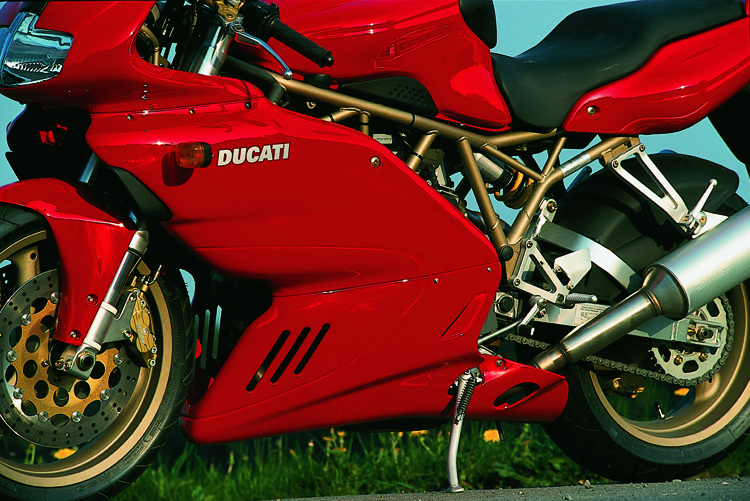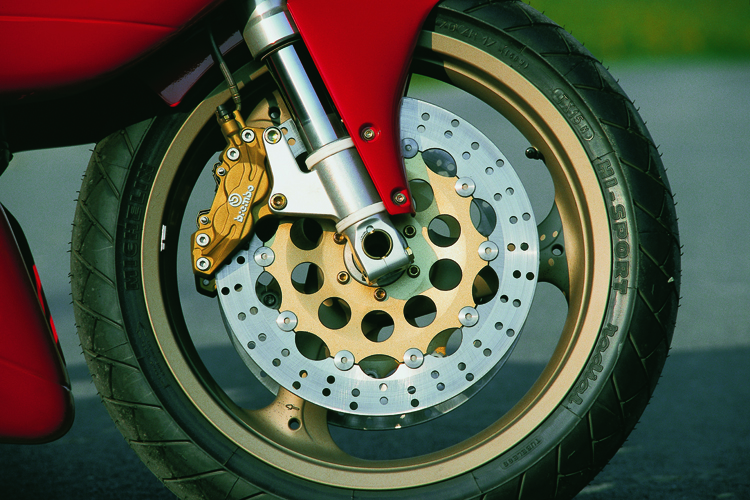Ducati Supersport 900

Ducati's success during the nineties is based on one of the most popular sportbikes from Italy, the 900 SS. This great heritage led to the first fuel-injected SS in 1998 (USA: 1999).
Ferrari, pasta, chianti, cappuccino…Italy and its traditional products reflect a wide range of fine, exclusive lifestyles. That's the same for fashion and industry as well as recreational products. And almost everything that has wheels is special due to its performance and its design - most of all the exciting cars and motorcycles. No doubt about it, Ducati is one of these mosaic pieces that made Italian motorcycles popular all over the world.
Since 1996, this traditional brand has had a new owner, the Texas Pacific Group from California. The new investors are trying to put their economic house in order by rearranging management, production, distribution and franchising. Part of this effort is to improve the present range of models and to develop new products. The Supersport 900 is a good example of targeted development and changes within limits that don't affect the great heritage of the SS-range.

SS-HERITAGE
SS, two letters that celebrated great motorcycle victories and success in the seventies after winning the 200 miles of Imola in 1972 on a bevel drive V 2 (bevel drive to the cams). Almost twenty years later, Ducati introduced a new SS-line with belt-drive engines based on the highly improved and enlarged old Pantah-V 2. These bikes were the basis for the upswing of the Italian brand and their increasing sales in the nineties. In 1998, the introduction of an all around improved 900 SS model with modern fuel injection took place. One year later the new SS entered the US market.
Characteristics of the 'injezione elettronica' are the close fitting full-fairing around the tubular steel cage frame. A shape that looks like the clothes of the single racer Supermono. It's the same with the fuel tank and the wide round tail section, they could come from the SM too. No wonder - Mr. Pierre Terblanche was responsible for both of these designs.

Engine & Transmission
Besides the appearance, there were some big changes made to the engine. First of all, the belt-drive, two-valve engine has other cams with new timing and larger valve lift. Together with a lighter flywheel on the end of the crank and the new fuel injection, the V 2 is in a hurry like never before. Throttle response is good from 2,500 rpm, the big pull starts at 4,000 rpm and continues easily up to eight or nine thousand. The V-Twin claims 80 hp at 7,500 rpm. On public roads even the four-valve Ducs have to be ridden hard to follow the SS genius. And - with all those speed limits in this country - it's more than enough, trust me! The police won´t catch you!
But seriously, this engine is a masterpiece, even if it already shows some wrinkles on its forehead or better on its air-cooled fin-barrels (for 2001; before air- and oil-cooled). Performance on public roads is better than a 600 Supersport, because the Duc-engine has better torque. Of course, at high revs or on the track the 600s will catch up to you and pass due to better high-end power. The short-shifted gearbox of the Supersport with close ratios helps you make up for some horsepower as well.

Chassis & Brakes
One of the typical features of a Ducati is the tubular steel cage frame. Unlike most of the other factories that use cast alloy frames nowadays the Italians believe in their steel construction. And they are right about this, because the Supersport chassis is light and stable at the same time. The aluminum swingarm is mounted to the rear of the engine cases. That saves some weight, too, and is sturdy enough for the use on public roads. On curvy canyon backroads the Supersport perfectly follows the riders commands and runs a very exact line. Nevertheless, in very tricky narrow corners you will face a little bit of heavy steering, and it takes more effort to lean over from one corner into the other than on a modern Japanese sportbike. But that's the price you pay for the trustworthy stability of the 900 and that also is a result of great working forks and rear shock. On the other hand, you shouldn't expect too much comfort, this a pure Italian sportbike.
And truly, these reliable brakes that Brembo throws in fit this package. Since the introduction of the fuel-injected SS in 1998 (USA 1999), Ducati uses other calipers in the front with wider mountings for more brake stability. Additionally, you find a nice handlever arrangement with a separate reservoir for the brake fluid and steel-braided brake lines that give you more feeling for your stoppers.

Accessories & Arrangements
Overall, the Duc offers an impressive standard of European quality and a wonderful design. That's what makes Italian sportbikes so desirable. They look like they came right from the racetrack and the seating position is very clearly on the sporty side. But it's really surprising how easy it is to go touring with it - if you compare it to other sport bikes. The passenger on the rear seat sits on a comfortable upholstery and his footpegs don't force him to fold his legs that much. Under the seat you find some space for tools, tire repair kit or your raingear. Forks and rearshock are fully adjustable so that you can get more comfort out of them, if you want to. And the 16-liter fuel tank (4.2 gallon) gives you a fuel range of 254 kilometers (159 miles). Not too bad for a 'crotch rocket!' Don't you think?

Test Summary
At the end of a long day with plenty of canyon roads you know what it means to ride an Italian stallion. Of course you have to bend over more than on a cruiser or a tourer. But that gets paid off by the incredible stability in turns, the impressive pulling engine with a lot of midrange power and the wonderful Desmo sound. Touring, no way, you think? If you ride only curvy backroads all day long you will enjoy it. On the other side, the Duc is definitely not built for boring, straight highways. Of course, there are others that can do that a lot more entertainingly. The Supersport 900 has a strong need for turns!

Technical Specs
Retail price $ 10,595 (half fairing); $ 11,295 (full fairing)
Warranty Two years, unlimited miles
Maintenance schedule 600/6,000/every 6,000 miles (1,000/10,000/every 10,000 km)
Importer/distributor Ducati North America
237 W. Parkway,
Pompton Plains, NJ 07444-1028
phone (973) 839-2600
Engine
Type 2-cylinder V, 4-stroke
Cooling Air-cooled
Valve arrangement 2 valves per cyl., ohc, cams belt driven, desmo-rockers for valve opening and closing
Bore & Stroke 92 x 68 mm
Displacement 904 cc
Compression ratio 9.2:1
Carburetion Electronic fuel injection
Transmission
Gearbox 6-speed
Clutch Multi-plate dry clutch
Final drive Chain drive
Chassis
Frame Tubular steel cage frame
Wheelbase 1,395 mm (54,9 in.)
Rake 66 degree
Trail 100 mm (3.9 in.)
Front suspension Upside-down-cartridge fork
Stanchion diameter 43 mm (1.38 in.)
Adjustments Spring preload, compression and rebound damping
Travel 120 mm (4.7 in.)
Rear suspension Alloy swingarm w/single shock
Adjustments Spring preload, compression and rebound damping
Travel 136 mm (5.4 in.)
Wheels & Tires
Type Cast alloy wheels
Front 3.50 x 17
Rear 5.50 x 17
Front Tire 120/70 ZR 17
Rear Tire 170/60 ZR 17
Brakes
Front brake discs, 4-piston calipers
Diameter 320 mm (12.6 in.)
Rear brake 1 disc, 2-piston caliper
Diameter 245 mm (9.6 in.)
Combining -
Weight & Fuel Capacity
Wet-Weight 204 kg (453 lb.)
Fuel capacity 16 l (4.2 gal.)
Performance
Claimed Horsepower (crank) 79 hp at 7,500 rpm
Torque 7.7 mkp (57 ft. lbs..) at 6,500 rpm
Top speed 223 km/h (139 mph)
Acceleration 0-100 km/h (0-62.5 mph): 3.5 s
Fuel consumption 6.3 l/100 km (37.7 mpg)
Fuel range 254 km (159 miles)
Equipment
Full-fairing, dashboard w/speedometer, tachometer and oil temperature gauge, indicator light for fuel reserve, key switch in front of the upper triple clamp, adjustable hand levers, side stand.
RoadRUNNER Test Diagram
Engine 4/5
Chassis 4/5
Brakes 4/5
Comfort 3/5
Luggage w/accessories 2/5
Equipment 3/5
Design 4/5
Bike for the buck 3/5